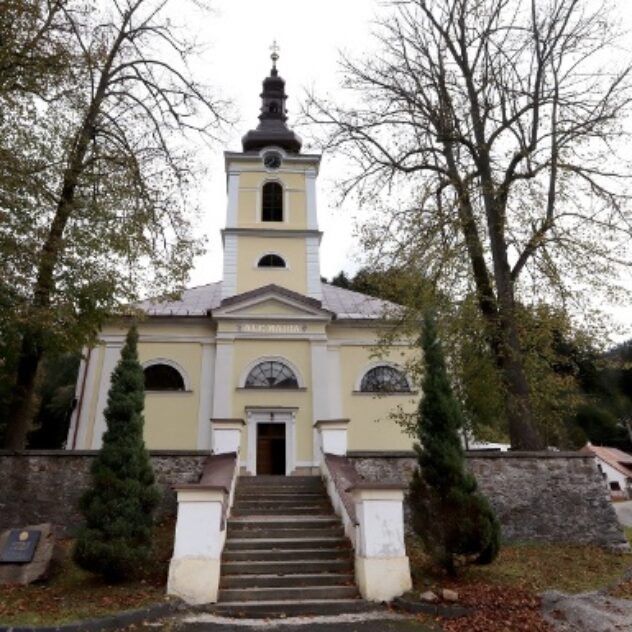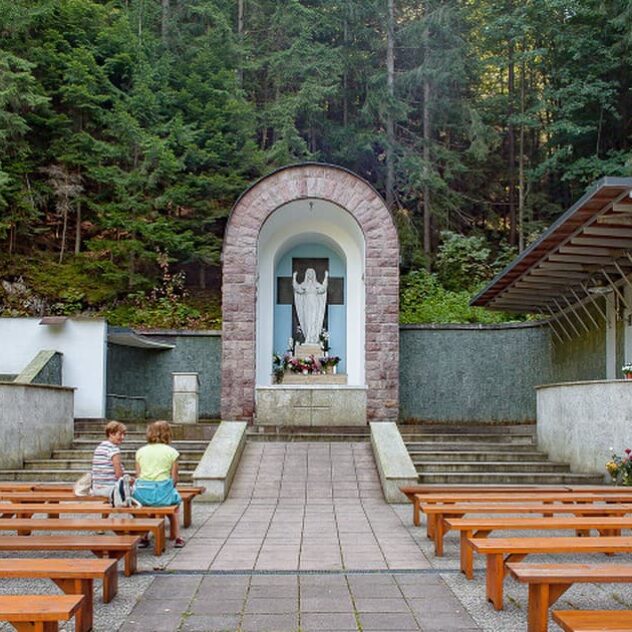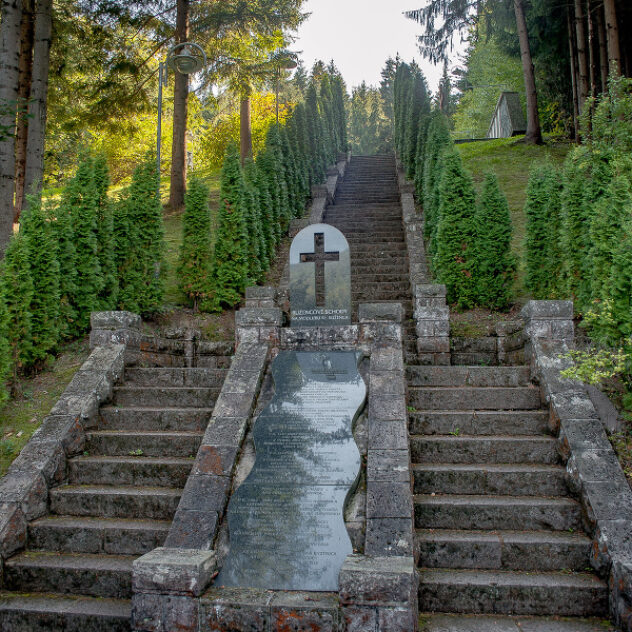Basilica of the Visitation of the Virgin Mary in Stary Hory
Information about the pilgrimage site
Staré Hory is a Marian pilgrimage site with a rich history and tradition. The settlement of Staré Hory was originally a small mining settlement. The dominant feature of this pilgrimage site is the Gothic Basilica of the Visitation of the Virgin Mary. On the altar there is a precious 15th century sculpture of the Madonna, which is a destination for pilgrims.
The area of the pilgrimage site today consists of a calvary, chapels, the top neo-gothic Chapel of the Virgin Mary of the Seven Sorrows and, last but not least, a well with a healing spring. Apart from the Basilica, the fountain is of particular importance. This is the place where the inhabitants of Staré Hory hid a statue of the Virgin Mary during the civil unrest in the 17th century. In 1711 it was dug up and brought to the altar in a solemn procession. To commemorate its hiding, an image of the Virgin Mary was erected on the site. In the 19th century, the spring of the Fountain brought healing to the then parish priest Matej Hrivňák, who had a worthy stand made in gratitude to the Madonna, and at the same time the path to the fountain was also improved. The pilgrimage site has witnessed many healings, the attainment of various divine graces and gifts of the Holy Spirit. This is evidenced by the many thanksgiving tablets and prayers that are placed on the walls of the church and around the Well.
In addition, the pilgrimage site has an ancient tradition and the special privilege of purification from sins. Through the Sacrament of Penance and in the spirit of the idea of “Per Mariam ad Jesum”, a visit to the pilgrimage site, together with Holy Confession, Holy Communion and prayer, has been rewarded with plenary indulgences since 1780. This privilege was rare and precious at that time.
In 1990, the Church of the Visitation of the Virgin Mary was declared a minor basilica. Nowadays, tens of thousands of pilgrims from Slovakia and neighbouring countries travel to Staré Hory and it is the most visited pilgrimage site in central Slovakia. The main pilgrimage takes place around the feast of the Assumption of the Blessed Virgin Mary (15 August) and also every first Saturday of the month – the so-called Fatima Saturdays.
Tourist attractions in the vicinity
Špania Dolina – today a picturesque village, which in the past was famous throughout Europe for its copper ore deposits, which also contained silver. The beginnings of mining in this locality can be dated back to the 11th-12th centuries. The buildings of this picturesque village consist of small scattered miners’ houses on the steep slopes of the valley. In the central square there are former administrative and technical buildings, especially the mining administration building. The Church of the Transfiguration, which stands on a hill in the fortified area, is worth a visit. The greatest rarity of the church is the Baroque organ from 1751 – one of the most important organs of the late Baroque period in Slovakia.
Donovaly – a former mountain homestead, today an important centre of winter and summer tourism. Popular is the ski resort Park Snow Donovaly, visitors can visit the fairy-tale world of Habakuky (a fairy-tale village based on the fairy tales of the famous author Pavel Dobšinský), the Fun Arena with a toboggan bobsled run, a rope centre and a climbing wall in the summer. Another attraction for the children’s visitor is the Donovalkovo interactive village.
Banská Bystrica – is the natural centre of central Slovakia. The history of the town began in the 13th century, when ores were extracted here by surface mining. The original settlement became an economic and administrative centre and King Belo IV elevated it to the status of a town. The golden era in the history of Banská Bystrica was the period of the 15th and 16th centuries, when the successful Thurz-Fugger copper company operated here. An important chapter in the modern history of the town is the Slovak National Uprising in 1944, when Banská Bystrica became the centre of the anti-fascist resistance. This historic town is dominated by several monuments such as the Clock Tower, Marian Column, Barbican, the Cathedral of St. Francis Xaversky, the Town Hall and the Thurzo House, etc.
Harmanecká Cave – it is a stalactite cave in the Kremnické Hills and Starohorské Hills and is a national natural monument. It has a length of just over 3 kilometres, and is open to the public for about 1 kilometre. The air temperature in the cave ranges from 5.8°C to 6.4°C. The cave is known for its abundant white soft sinter and has rich decorations, wall waterfalls and curtains. In some parts of the cave there are pools with rare cave pearls. Interestingly, it is one of the most important sites of bats in Slovakia, so far 11 species have been found.
Kalište – a former mountain village, today it is a national cultural monument, which was burnt down at the end of the Second World War. To this day, it remains a memento of times past and houses an exposition of the Museum of the Slovak National Uprising in Banská Bystrica. It consists of preserved houses, a cemetery, a chapel and the graves of fallen partisans.
Other tourist attractions in the vicinity of the pilgrimage site can be found on the website of the Banská Bytrica Regional Tourism Organisation https://kocr.dobrykraj.sk/ or the Regional Tourism Organisation
Accommodation
- Accommodation for pilgrims directly on the Old Mountains is currently not available
- Other private accommodation in Stary Hory or in the surrounding villages, or in the Donovaly recreation centre.
Availability
By car
Accessibility by car is the fastest. From the nearest town of Banská Bystrica, Staré Hory is only 11 km away. From Banská Bystrica it is necessary to take the exit to the 1st class road number 59. There is a parking lot for cars and buses directly in front of the Basilica.
By public transport
It is possible to get to the village Staré Hory by bus from the nearest town Banská Bystrica or from the more distant Ružomberok. The pilgrimage area is near the bus stop. The frequency of bus transport is relatively high.
On foot
The pilgrimage site is most often visited on foot by the faithful from the surrounding parishes in the spring, summer or autumn months. The pilgrimage site is not only interesting for pilgrims, but it is also a tourist destination from several surrounding localities. Hiking routes according to difficulty can be found, for example, at www.mapy.cz.
On a bicycle
Accessibility by bicycle is on roads or forest trails, but you have to take into account the higher difficulty, as it is a mountainous terrain. Cycling routes can be looked up e.g. at www.mapy.cz.








